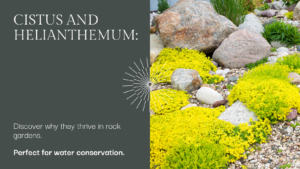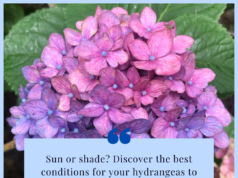
If you’re looking to create a stunning rock garden that can add an extra dimension of beauty to your outdoor space, selecting the right plants is critical. Cistus and helianthemum are two excellent choices that can enhance the appeal of your rock garden and make it stand out.
Cistus, also known as the rock rose, and helianthemum, also called the sun rose, are both highly adaptable plants that are well-suited for rock gardens. They are drought-tolerant, prefer well-draining soil, and can thrive in various conditions. Both cistus and helianthemum also provide vibrant bursts of color and pleasant fragrances.
Key Takeaways:
- Cistus and helianthemum are ideal plants for rock gardens.
- They are drought-tolerant and can thrive in various conditions.
- Both plants provide lovely colors and fragrances.
- Selecting the right plants is crucial for the success of your rock garden.
- Rock gardens are attractive additions to outdoor spaces that can add extra beauty.
Introduction to Rock Gardens and Their Appeal
Rock gardens are a popular landscaping trend that can transform an ordinary outdoor space into a stunning display of natural beauty. Featuring a variety of rocks, stones, and specialized soil, rock gardens are designed to mimic the look and feel of a mountainous terrain.
The appeal of these gardens lies in their ability to provide a low-maintenance yet visually attractive landscape that combines elements of hardscaping and gardening. Whether you live in a region with challenging soil conditions or simply want to enhance your garden’s visual appeal, rock gardens can give your property a unique and eye-catching look.
Moreover, rock gardens have the added benefit of being ideal for growing plants that are well-suited to rocky, drought-prone soils. These types of plants are typically hardy and have developed the ability to thrive in challenging conditions, making them a natural choice for a rock garden.
Captivating Features of Rock Gardens
- Low-maintenance outdoor space with minimal upkeep
- Incorporation of plants that thrive in rocky, drought-prone soils
- A unique blend of hardscaping and gardening elements for an eye-catching look
- The potential to create natural-looking themes, such as alpine or desert landscapes
Importance of Choosing Suitable Plants
To achieve a successful rock garden, you must carefully select suitable plants. Not all plants are created equal, and some may not thrive in the harsh growing conditions of a rock garden. Choosing the right plants will help create a thriving garden that will last for many years to come.
The harsh conditions of rock gardens, such as poor soil quality, limited moisture, and intense sunlight, make it challenging for many plant species to survive. Therefore, when selecting plants for your rock garden, it’s essential to choose those that are adapted to these conditions. Suitable plants will require less maintenance and will be more likely to thrive in the environment.
Native plants to your region are always an excellent choice for rock gardens, as they are accustomed to the environmental conditions. They have developed natural defenses against pests and diseases, which make them more resilient and easier to care for.
Characteristics of Suitable Plants
| Characteristics | Description |
|---|---|
| Drought-tolerant | They should be able to survive with minimal water. |
| Tolerant of full sun exposure | The plants should be able to tolerate prolonged hours of direct sunlight. |
| Adaptable | They should be able to adjust to different growing conditions. |
| Hardy | They should be able to withstand extreme weather conditions. |
By carefully selecting suitable plants and paying attention to their specific growing conditions, you can create a thriving rock garden that adds beauty and charm to your outdoor space.
Cistus: The Rock Rose
Cistus, also known as the rock rose, is a shrub that belongs to the Cistaceae family. It is native to the Mediterranean region and is well-known for its beautiful flowers and resinous leaves.
The rock rose is characterized by its hairy stems and foliage, which helps it retain moisture in arid conditions. The leaves are evergreen and have a greyish-green hue. They are typically lance-shaped and grow up to 10 cm in length.
The flowers of the rock rose are the main attraction for gardeners. They bloom in a wide range of colors, from white to pink, purple, and red, and have a distinctive papery texture. The flowers are saucer-shaped and have a bright yellow center, which is surrounded by a ring of prominent stamens.
The rock rose is well-suited for hot and dry conditions and can thrive in poor soils. It prefers full sun exposure and is not tolerant of shade or heavy moisture. To encourage optimal growth, it is recommended to prune the plant after flowering.
Facts about Cistus:
- The rock rose is also known for its medicinal properties, with extracts being used for their antibacterial, antifungal and anti-inflammatory effects.
- There are over 20 different species of cistus, with many more cultivars available to gardeners.
- The rock rose has a long history of cultivation, with evidence of its cultivation dating back to ancient Greece and Rome.
Adaptability of Cistus to Rock Gardens
Cistus, also known as the rock rose, is a particularly suitable plant for rock gardens due to its ability to adapt to various growing conditions. With its impressive drought tolerance and preference for well-draining soil, cistus is ideal for areas with low rainfall and rocky soil. The plant thrives in full sun and is resistant to heat and humidity, making it ideal for gardens located in hot, arid climates.
When planting cistus, ensure that the root ball is fixed firmly in the ground and water it frequently until it becomes fully established. Once established, cistus requires little water, allowing it to thrive in arid conditions.
While cistus is adaptable to various growing conditions, it is important to note that it is sensitive to high humidity and excessive moisture, which can cause fungal disease to develop. To avoid this, it is recommended to avoid watering cistus from above and to maintain well-draining soil.
Tip: Consider planting cistus in raised beds or on slopes, as this will provide extra drainage and reduce the risk of fungal diseases.
Popular Cistus Varieties for Rock Gardens
Cistus is a diverse genus with a wide range of species that vary in size, shape, and color, providing ample choices for rock gardens. Here are some popular varieties to consider:
| Variety | Notable Features | Blooming Periods |
|---|---|---|
| Cistus x pulverulentus ‘Sunset’ | Large pink flowers with yellow centers | Spring through summer |
| Cistus creticus | Deep green leaves, bright pink flowers, and cinnamon-scented foliage | Late spring through late summer |
| Cistus ‘Little Miss Sunshine’ | Compact growth habit, crinkly green leaves, and yellow flowers | Late spring through early summer |
| Cistus albidus | Low growing shrub with silver-green leaves and white flowers with yellow centers | Spring through early summer |
These cistus varieties are not only beautiful and low-maintenance, but they also require minimal watering and can tolerate heat and drought conditions, making them perfect for rock gardens. Consider adding one or more of these options to your rock garden for year-round interest and visual appeal.
Helianthemum: The Sun Rose
If you’re searching for a fiery plant that can infuse your rock garden with bold color, consider helianthemum or the sun rose. This low-growing evergreen shrub is native to Europe and thrives in hot, dry climates. Helianthemum is prized for its profuse and showy blooms, which range from bright yellow to rich red and intriguing shades of pink and orange.
The sun rose gets its name from its preference for full sun and well-draining soil. It reaches a mature height of 12 to 24 inches and has a spread of up to 36 inches. Despite its delicate appearance, helianthemum is a tough plant that’s resistant to pests and drought.
“The sun rose is a stunning addition to rock gardens and is adored by gardeners for its vibrant blooms and resilience,” says Mary Williams, a landscape designer with over 15 years of experience.
Helianthemum Varieties
There are many helianthemum cultivars that you can choose from to create a beautiful rock garden. Varieties such as “Henfield Brilliant” produce rose-pink flowers that light up your garden in early summer. “Ben Fhada” produces striking pale yellow blooms in late spring, while “Wisley Primrose” blooms in creamy yellow.
| Variety | Bloom Color | Blooming Period |
|---|---|---|
| Henfield Brilliant | Rose-Pink | Early Summer |
| Ben Fhada | Pale Yellow | Late Spring |
| Wisley Primrose | Creamy Yellow | Summer |
When selecting a helianthemum variety, take into consideration factors such as its height and spread, hardiness, and bloom time. By selecting the right cultivar and planting it in the right location, you can enjoy the stunning beauty of the sun rose for years to come.
Benefits of Incorporating Helianthemum in Rock Gardens
When planning your rock garden design, consider including helianthemum as a complementary plant to cistus. This sun-loving plant is also known as the sun rose and is prized for its vibrant, delicate flowers and evergreen foliage.
One of the benefits of incorporating helianthemum in your rock garden is that it is a low-maintenance plant that thrives in dry, well-drained soil. This makes it an ideal candidate for rock gardens that offer excellent drainage.
Helianthemum is also an excellent choice for adding vertical interest to your rock garden. Its natural tendency to spread and spill over rocks and other plants creates a beautiful cascade effect, adding depth and texture to your rock garden design.
In addition, helianthemum’s small size makes it perfect for rock gardens of any size. Whether you have a small rock garden in your yard or large garden landscaping, you can easily incorporate several helianthemum plants to create a beautiful, cohesive design.
Overall, helianthemum is an excellent addition to any rock garden design, offering low-maintenance care, vertical interest, and a beautiful pop of color with its vibrant flowers.
Different Helianthemum Cultivars for Rock Gardens
Helianthemum, also known as the sun rose, is a charming addition to any rock garden. Its yellow, pink, and white flowers bloom in profusion throughout the summer and attract pollinators like bees and butterflies.
When choosing the right helianthemum cultivar for your rock garden, consider factors like color preference, size, and growing conditions. Some popular varieties include:
| Variety | Color | Height (inches) | Spread (inches) | Exposure | Bloom Period |
|---|---|---|---|---|---|
| Henfield Brilliant | Bright red-orange | 6-8 | 8-10 | Full sun | May to July |
| Ben Fhada | Yellow | 6-12 | 12-18 | Full sun | June to August |
| Wisley Primrose | Soft pink | 4-6 | 12-14 | Full sun | June to September |
| The Bride | Pure white | 4-6 | 12-14 | Full sun | May to June |
As with cistus, provide helianthemum with well-draining soil and avoid overwatering. Mulching around the base of the plant with gravel can help retain moisture and regulate soil temperature.
Comparing Cistus and Helianthemum for Rock Gardens
Choosing the right plant species for your rock garden is essential for its growth and long-term maintenance. Both cistus and helianthemum have unique qualities and characteristics, each adding their own flair to a rock garden. Here’s a comparison of the two plants to help you make an informed decision for your garden.
Cistus (Rock Rose)
| Quality | Description |
|---|---|
| Appearance | The delicate flowers bloom in shades of pink, white, and purple, bringing a pop of color to any rock garden. |
| Adaptability | Cistus thrives with good drainage and full sunlight, making it ideal for rock gardens in warm, dry climates. |
| Hardiness | Cistus is drought and heat tolerant, making it an excellent choice for gardens that require minimal maintenance. |
Helianthemum (Sun Rose)
| Quality | Description |
|---|---|
| Appearance | Helianthemum boasts vibrant, sun-loving blooms in yellow, orange, pink, and red hues, adding a bright and cheerful touch to rock gardens. |
| Adaptability | Helianthemum thrives in well-drained soil and ample sunlight, making it perfect for rock gardens in hot and dry regions. |
| Hardiness | Helianthemum is drought resistant and cold hardy, thriving in a variety of temperatures and surviving winter weather with ease. |
While both plants have similarities, their differences make them useful in varying environments. Cistus thrives best in warm conditions, while helianthemum is hardy to cold weather. You can add the striking cistus for a pop of pink or purple in your rock garden, or opt for helianthemum with vibrant reds and yellows. It’s all a matter of preference and how you want to structure your garden.
Whichever species you choose for your rock garden, both cistus and helianthemum are valued for their unwavering beauty and low maintenance requirements. With their adaptability and charming appearance, they are the perfect plants to create a striking rock garden that everyone will admire.
FAQ
Q. Why are cistus and helianthemum well-suited for rock gardens?
A. Cistus and helianthemum are well-suited for rock gardens due to their adaptability to the specific growing conditions in these gardens, their ability to thrive in well-drained soil, and their appealing qualities that enhance the natural beauty of rock formations.
Q. What makes rock gardens appealing?
A. Rock gardens are appealing because they provide a unique landscape design element, create a visually striking display, require minimal maintenance, allow for water conservation, and offer an opportunity to grow a variety of plants in challenging conditions.
Q. Why is it important to choose suitable plants for a rock garden?
A. Choosing suitable plants for a rock garden is crucial because they need to be able to tolerate the specific conditions found in this type of garden, such as poor soil, drought, and harsh weather. Selecting appropriate plants ensures they will thrive and contribute to the overall beauty of the garden.
Q. What are the characteristics and natural habitat of cistus?
A. Cistus, also known as the rock rose, is a flowering shrub native to the Mediterranean region. It has evergreen foliage, often with silvery or gray-green leaves, and produces beautiful, showy flowers in various colors. Cistus grows naturally in dry, rocky areas.
Q. How does cistus adapt to rock gardens and specific growing conditions?
A. Cistus is well-adapted to rock gardens because it thrives in well-drained soil, withstands drought, and tolerates full sun exposure. Its natural habitat in rocky areas makes it an ideal choice for rock gardens, where it can enhance the rugged beauty of the landscape.
Q. What are some popular cistus varieties for rock gardens?
A. Some popular cistus varieties for rock gardens include Cistus × purpureus (Purple Rock Rose), Cistus crispus (Wrinkled Rock Rose), Cistus ladanifer (Gum Cistus), and Cistus monspeliensis (Montpellier Rock Rose). These varieties offer unique features and bloom at different periods, providing color and interest throughout the seasons.
Q. What are the characteristics of helianthemum?
A. Helianthemum, also known as the sun rose or rock rose, is a low-growing perennial plant that forms dense mats of evergreen foliage. It produces vibrant, delicate flowers in shades of yellow, orange, pink, and white. Helianthemum is known for its ability to adapt to various soil types and its preference for full sun exposure.
Q. What are the benefits of incorporating helianthemum in rock gardens?
A. Incorporating helianthemum in rock gardens adds a pop of color, creates contrast against the rocky backdrop, attracts pollinators, offers ground cover, and contributes to the overall natural beauty of the garden. Its ability to withstand harsh conditions and adapt to different soil types makes it an excellent choice for rock gardens.
Q. What are some different helianthemum cultivars for rock gardens?
A. Different helianthemum cultivars suitable for rock gardens include Helianthemum nummularium ‘Wisley Pink’, Helianthemum nummularium ‘Henfield Brilliant’, Helianthemum nummularium ‘Ben Ledi’, and Helianthemum nummularium ‘Fire Dragon’. Each cultivar offers unique flower colors and characteristics, allowing you to choose the right one for your rock garden.
Q. What factors should I consider when choosing the right helianthemum variety for my rock garden?
A. When choosing the right helianthemum variety for your rock garden, consider factors such as flower color, bloom time, growth habit, cold hardiness, and overall plant size. Assessing these characteristics will help you select a variety that complements the existing plants in your rock garden and meets your specific aesthetic preferences.
Q. How do cistus and helianthemum compare for rock gardens?
A. Cistus and helianthemum both have their own unique qualities that make them great choices for rock gardens. Cistus offers larger, showier flowers and evergreen foliage, while helianthemum provides a low-growing habit, a wide range of flower colors, and excellent adaptability. Consider the desired aesthetic, size constraints, and specific growing conditions of your rock garden to determine which plant is the best fit.
Conclusion
In conclusion, incorporating cistus and helianthemum in your rock garden design has numerous advantages. Both plants are well-suited for rock gardens, and choosing the right plants is crucial for the success of your garden. Cistus, also known as the rock rose, thrives in the specific growing conditions of rock gardens and is available in many popular varieties. Helianthemum, or the sun rose, adds a unique touch to your garden and complements other plants.
By comparing the qualities of cistus and helianthemum, you can decide which plant to select for your rock garden. Regardless of your choice, both plants are excellent options for creating a beautiful and vibrant rock garden. Remember to provide the necessary growing conditions and care for your plants to ensure their long-term success.
Thank you for reading, and we hope this article has provided you with valuable insights into the advantages of using cistus and helianthemum in rock gardens. Happy gardening!
















